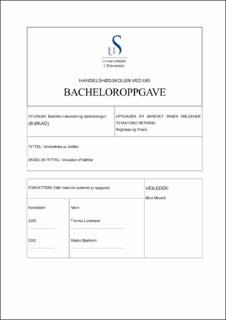| dc.contributor.advisor | Misund, Bård. | |
| dc.contributor.author | Bjørheim, Marius. | |
| dc.contributor.author | Lundmann, Thomas. | |
| dc.date.accessioned | 2023-07-04T15:53:54Z | |
| dc.date.available | 2023-07-04T15:53:54Z | |
| dc.date.issued | 2023 | |
| dc.identifier | no.uis:inspera:145995936:70127790 | |
| dc.identifier.uri | https://hdl.handle.net/11250/3075704 | |
| dc.description.abstract | I denne verdsettelsen analyserer vi hele SalMar konsernet, et norsk oppdrettsselskap som har flere driftssegmenter. Den største delen av produksjonen skjer i Midt-Norge, mens den nest største produksjonen skjer i Nord-Norge. SalMar har gjennom flere år levert høy lønnsomhet, og vokst kraftig. SalMar leverer laks til hele verden, og det største markedet er Europa. Problemstillingen er inspirert av finansdepartementets innføring av grunnrenteskatt på havbruk, og definert som:
“Hva er verdien av en SalMar-aksje, med grunnrenteskatt og uten grunnrenteskatt, og hvor stor er forskjellen?”
Oppgaven starter med å introdusere lakseoppdrettsnæringen, SalMar som konsern og Norges skattesystem med grunnrenteskatt som hovedfokus. Videre presenteres verdsettelsesmåten, der vi hovedsakelig bygger på teoriene til Answath Damodoran.
Analysen av SalMar som blir brukt til å prognosere fremtidige kontantstrømmer, tar først for seg en strategisk analyse, gjennom en intern- og en ekstern- analyse. Videre blir det gjort en regnskapsanalyse for å finne trender, og for å se hvordan selskapet har prestert de siste fem årene. Dette grunnlaget blir brukt for å estimere fremtidig kontantstrøm. Vi presenterer også avkastningskravet, og hvordan vi har kommet frem til det.
I siste del av oppgaven diskonterte vi de fremtidige kontantstrømmene, og regner ut sluttverdien til selskapet. Videre finner vi markedsverdien på totalkapitalen, både med og uten grunnrenteskatt. Markedsverdien på egenkapitalen blir derifra regnet ut ved å trekke fra gjelden. Egenkapitalverdien med og uten grunnrenteskatt blir brukt til å regne ut aksjeverdien, og vi sammenligner estimert aksjekurs med kursen på børsen. Vi estimerte aksjekursen til 450 NOK med grunnrenteskatt, og 945 NOK uten grunnrenteskatt. Oppgaven blir avsluttet med en sensitivitetsanalyse, hvor vi viser hva endringer i kontantstrømmen, avkastningskravet og veksten gjør med estimert aksjekurs. | |
| dc.description.abstract | In this valuation, we analyze the entire SalMar group, a Norwegian aquaculture company that has several operational segments. The largest part of the production takes place in Mid-Norway, while the second-largest production takes place in Northern- Norway. SalMar have delivered high profitability for several years and have grown significantly in recent years. SalMar delivers salmon to the whole world, and the largest market is Europe. The problem statement is inspired by the introduction of resource rent tax on aquaculture and is defined as:
"What is the value of a SalMar share, with and without resource rent tax, and how big is the difference?"
The thesis begins by introducing the salmon farming industry, SalMar, and Norway's tax system, with a focus on resource rent tax. Furthermore, we present the valuation method, which is mainly based on the theories of Answath Damodoran.
The SalMar analysis used to forecast future cash flows, starts with a strategic analysis through an internal and external analysis. Further, an accounting analysis is done to identify trends and see how the company has performed over the last five years. This is the basis for the estimates we use to estimate future cash flows. We also present the required rate of return, and how we estimated it.
In the final part of the task, we discount the future cash flows and calculate the final value of the company. This is combined, to find the market value of equity, both with and without resource rent tax. The market value of equity is used to calculate share prices with and without resource rent tax, and we also compare estimated share prices with the stock market price. We estimated the share price at 450 NOK with resource rent tax, and 945 NOK without resource rent tax. The thesis ends with a sensitivity analysis, showing how changes in cash flow, required rate of return, and growth changes the estimated share price. | |
| dc.language | nob | |
| dc.publisher | uis | |
| dc.title | Verdsettelse av SalMar | |
| dc.type | Bachelor thesis | |
